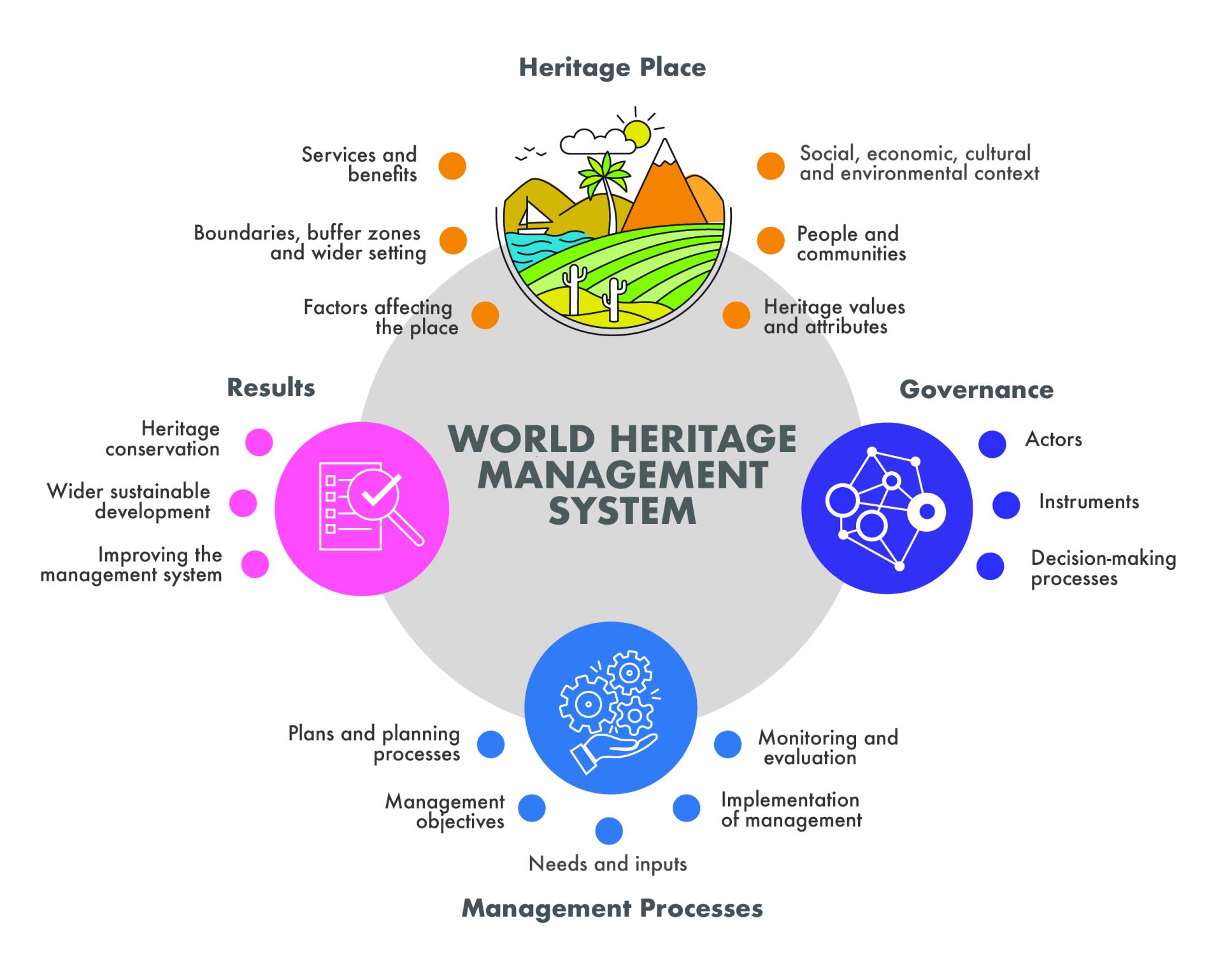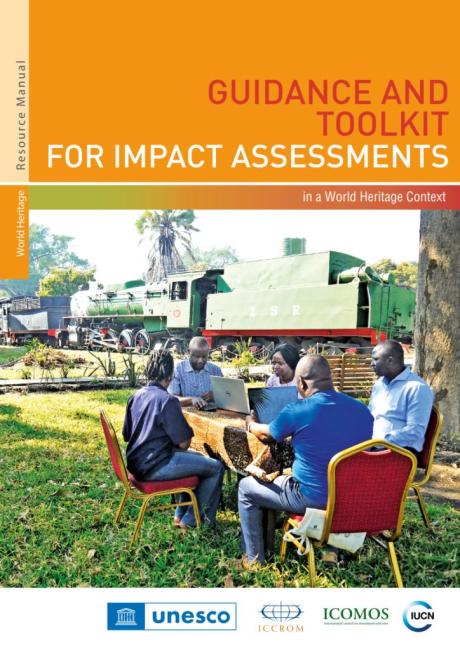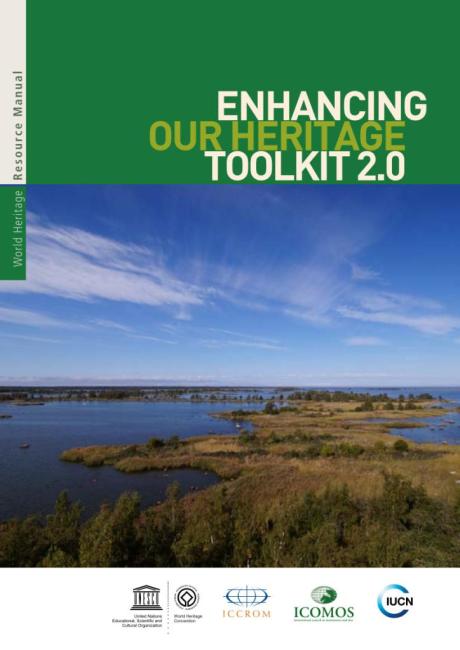What is this manual?
This manual recognizes that managing World Heritage is an ongoing and urgent challenge, which requires an integrated approach to management able to guide the evolution of properties over time within their social, economic and environmental contexts. Defined as the ‘heritage place approach’, this manual provides guidance on an approach to management that:
- emphasises the importance of maintaining the OUV of the
World Heritage property
A cultural, natural or mixed heritage place inscribed on the World Heritage List and therefore considered to be of OUV for humanity. The responsibility for nominating a property to the World Heritage List falls upon the State(s) Party(ies) where it is located. The World Heritage Committee decides whether a property should be inscribed on the World Heritage List, taking into account the technical recommendations of the Advisory Bodies following rigorous evaluation processes.
When used as a general term, World Heritage refers to all the natural, cultural and mixed properties inscribed on the World Heritage List. , but also recognizes its overall heritage significance, determined by the combination of and interactions between its different heritage values; - goes beyond the property boundaries to include any buffer zone(s), as well as the wider setting, and also considers the interactions between these different areas and between the property;
- requires rights-based and equitable partnerships with associated communities, participatory decision-making processes, as well as collaboration between institutions, sectors and governmental levels.
The manual is arranged into six parts. Following the present introduction in Part 1, the heritage place approach is explained in detail in Part 2. It is then organized further into four parts (Parts 3, 4, 5 and 6), grouping the main elements that an effective management system at a heritage place should have.
- Part 2: Using a heritage place approach as a basis for World Heritage management. This part establishes the conceptual framework for this manual. It shows how the heritage place approach recognizes the multiple layers of heritage significance and value of places and their interdependencies at different scales and how the application of this place-based approach to heritage management can bring many advantages. It then introduces what a heritage management system is, how it may vary considerably depending on the type, characteristics and needs of each heritage place and how the different elements included in that system should come together to ensure the protection and conservation of the heritage place.
- Part 3: Understanding the heritage place. This part explores the various aspects of a heritage place, starting with its heritage values (the reasons why a place is considered as heritage) and attributes (what elements of the heritage place convey those values and must therefore be conserved). These should form the basis for all management measures, starting from the delineation of the heritage place, defining its buffer zone(s) and understanding its wider setting. Effective management needs to be based on an understanding of the social, cultural, economic and environmental context, particularly when that context helps explain the various factors that can affect the heritage place and how to respond to them. Finally, the part explores the range of services and benefits that a heritage place can provide to associated communities as well as society at large.
- Part 4: Governance for heritage places. This part focuses on the different actors associated with the heritage place and how they should be involved in decision-making. An analysis of the various actors (managers, rights-holders, and stakeholders) involved at a heritage place helps to understand the responsibilities, rights and powers they hold over the heritage place and to determine the strengths and challenges of existing governance arrangements. The part also looks at the importance of legal and customary frameworks to ensure effective management of the
World Heritage property
A cultural, natural or mixed heritage place inscribed on the World Heritage List and therefore considered to be of OUV for humanity. The responsibility for nominating a property to the World Heritage List falls upon the State(s) Party(ies) where it is located. The World Heritage Committee decides whether a property should be inscribed on the World Heritage List, taking into account the technical recommendations of the Advisory Bodies following rigorous evaluation processes.
When used as a general term, World Heritage refers to all the natural, cultural and mixed properties inscribed on the World Heritage List. and its buffer zone(s) as well as addressing negative factors originating in the wider setting. - Part 5: Strengthening management processes. This part provides an overview of multiple management processes that occur at different levels and moments in time but which need to be coordinated. In particular, it looks at the processes to develop a specific management plan for the heritage place, with attention to its subsequent implementation and monitoring. It also explores other related processes such as: community engagement, disaster risk management (DRM), impact assessment, and tourism and visitor management.
- Part 6: Evaluating results and improving the management system. This part brings together all the elements and processes presented in previous parts and explains how it all comes together to ensure that the OUV and other heritage values of the
World Heritage property
A cultural, natural or mixed heritage place inscribed on the World Heritage List and therefore considered to be of OUV for humanity. The responsibility for nominating a property to the World Heritage List falls upon the State(s) Party(ies) where it is located. The World Heritage Committee decides whether a property should be inscribed on the World Heritage List, taking into account the technical recommendations of the Advisory Bodies following rigorous evaluation processes.
When used as a general term, World Heritage refers to all the natural, cultural and mixed properties inscribed on the World Heritage List. are maintained. It shows how the data collected from monitoring the state of conservation of the property can be used to identify changes in the condition of the attributes and to take informed management decisions - accordingly. Finally, it explores how regular assessments of the effectiveness of the management system help identify what is working well and what can be improved, in order to achieve the best conservation results with the resources available.
- Glossary: This manual is completed by a glossary of terms on World Heritage to promote a common understanding and clarity around key words used. The glossary also explains the specific way that certain terms are used in a World Heritage context and is designed to facilitate the translation of all the manuals into a range of languages to ensure that heritage managers can access these resources easily.

Figure 1.1 World Heritage All inherited assets which people value for reasons beyond mere utility. Heritage is a broad concept and includes shared legacies from the natural environment, the creations of humans and the creations and interactions between humans and nature. It encompasses built, terrestrial, freshwater and marine environments, landscapes and seascapes, biodiversity, geodiversity, collections, cultural practices, knowledge, living experiences, etc. Management System



